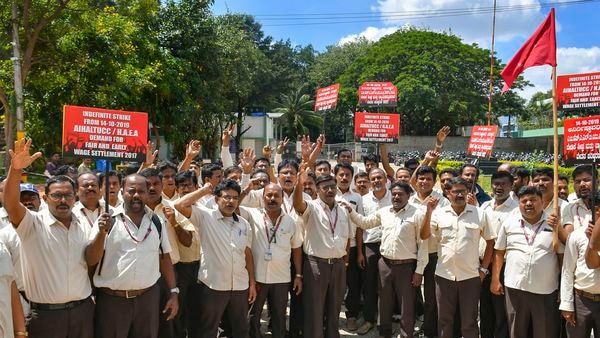In what yet again exposes the inefficient work culture of the Defence PSU, Hindustan Aeronautics Limited (HAL), it has been reported that the workers of the PSU spread across the nine units have begun an indefinite strike.
They are reportedly making several demands including wage revision.
All India HAL Trade Unions Coordination Committee (AIHALTUCC) chief convener Suryadevara Chandrashekhar said, “We are observing strike in all nine units of HAL all over India. More than 10,000 employees here are on strike and as a result work has come to a standstill.”
Meanwhile, the management has stated that it has made all efforts to reach an amicable solution. The management has stated, “Despite the management’s concerted efforts towards bringing an amicable and early wage settlement, unions unfortunately have adopted a recalcitrant approach and did not accept the offer and decided to resort to indefinite strike; in spite of management’s appeal not to resort to an indefinite strike and resolve the issue in a spirit of accommodation.”
This strike only strengthens concerns about the Defence PSU, which has already come under fire for inefficiency in operations. It has already emerged as a White Elephant, just like many other Public Sector Companies.
Last year, an audit by the Ministry of Defense (MoD) had revealed that the manufacturing cost of Sukhoi aircraft produced by the Bengaluru based PSU cost Rs 150 crore more than those manufactured by the parent company.
The review disclosed, “A Su-30MKI made in Russia cost Rs 269.77 crore whereas one made by HAL in India costs Rs 417.69 crore, almost ‘Rs 150 crore’ more per aircraft.”
The issue of HAL producing equipment at a higher cost and thereby causing unnecessary loss to the exchequer is not of recent origin.
In 2004, India has purchased British made hawk jets to train pilots. At the time of purchase, the cost of the jet was Rs 78 crore.
The Government of India entered in a deal to purchase 24 jets in fly-away condition while 38 jets were to be produced by HAL under British company’s license.
Interestingly, HAL produced the Hawk jets at Rs 88 crore per aircraft. HAL manufactured the Hawk jets at a much higher cost than the British company, notwithstanding cheap labour in India.
This is a marker of unsustainable inefficiency in HAL’s operations which leads to the PSU producing equipment at a much higher cost than the original manufacturer. And this is a deep-rooted issue with the Defence PSU.
Earlier this year, the previous Chief of Air Staff Air, Chief Marshal BS Dhanoa had taken a dig at Hindustan Aeronautics Limited (HAL) for not delivering defence equipment on time.
It must be noted that the HAL regularly shifted the delivery timing of equipment to the Indian Air Force (IAF).
At a lecture organized by the Centre for Air Power Studies, the then IAF Chief had said, “IAF has not shifted any goal posts as alleged. The development has taken such an incredibly long time that armament and technology has gone obsolete… I as the service chief can make concessions to Hindustan Aeronautics Limited (HAL). Will the enemy make concessions to me when I go and meet the enemy?”
He had also said, “In combat, there is no silver medal. Either you win or you lose.”
The IAF Chief’s remark once again highlighted how the inefficient work culture that seems to be deeply entrenched in the Defence PSU is detrimental to the national security of the country.
In the recent past, the inefficiency of the HAL has come to light time and again. The country has overcome the Nehruvian hangover and therefore, such blatant inefficiency on the part of a Defence PSU cannot be taken for granted.
The recent reports about a massive strike at the HAL which will in all probability bring the operations of the PSU to a halt sufficiently explain the reason behind the higher cost of production when equipment is manufactured at HAL.
It also explains why HAL has failed to build good fourth and fifth-generation aircrafts despite decades of existence.
Those who still live in the socialist era that had been thrust upon India right after her independence, correctly appropriate HAL to the Nehruvian legacy.
The sheer inefficiency and lack of purpose in HAL’s working are clear markings of Nehruvian socialism. The HAL is truly a vestige of Nehruvian socialism.
